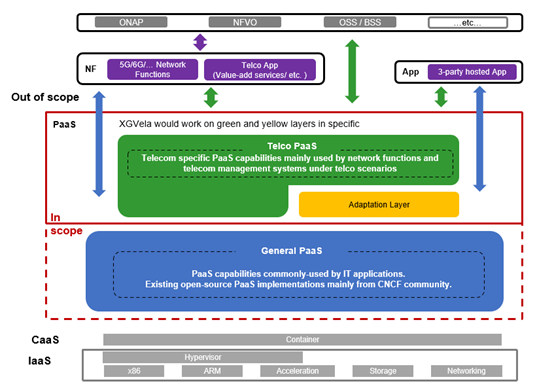1.0 Introduction – why telecom industry needs Cloud Native PaaS
Since NFV architecture was firstly proposed as ETSI standard in 2012, telecommunication industry and telecom operators have started the cloud transformation of network, moving network functions from dedicated physical devices to standard virtualized environment. By 2021, majority of global telecom operators have built Network Cloud, which is private cloud carrying 4G/5G network functions, value-added network functions, network management systems, network orchestration systems, etc. Operator representatives include AT&T, Verizon, Telstra, BT, DT, China Mobile, China Telecom, China Unicom, NTT, etc. Take China Mobile for example, by the end of 2020, China Mobile has built Network Cloud in 8 major districts within China to carry 37 types of network functions including 5GC, IMS, EPC. The proportion of network cloud is up to 75%, which keeps increasing with the construction of edge cloud.
...
According to the above analysis, cloud native PaaS, which refers to PaaS providing cloud native capabilities such as containers, microservice, automation tools, and cloud native network function components, is necessary and worth researching in telecommunication industry. Exploring cloud native PaaS in open source community can provide reusable capabilities and reference implementation for the industry.
2.0 PaaS Condition in Network Cloud
Although it can be predicted that cloud native PaaS can improve the flexibility of network cloud, if looking at current situation of telecommunication industry, it is not clear how to introduce PaaS into network cloud, or what PaaS capabilities are required by network. Most of the network clouds, which have been putting into use, follow NFV architecture and do not take PaaS as an independent system or visible object. These operators and vendors use virtual machines and containers directly as infrastructure, and package all required functional modules and software reliance into VNF delivery image. Figure 1 shows a simple diagram of current VNF condition that only resources are reused among VNFs while VNF related software are dedicated to each VNF.
...
- PaaS capabilities required to implement NF functions: This type of PaaS capability is necessary to achieve NF functions and logics, for example database, load balancer, protocol processing capability (PFCP, GTPU…), message bus, possible NF functional modulars, and some infrastructure related capabilities (such as hardware acceleration). User of this type of capabilities is mainly developers. These capabilities could be common among different NFs but unique for different venders/operators.
- PaaS capabilities required to manage NF functions: This type of PaaS capability helps to optimize the operation and management of network cloud, but has no direct influence on NF logics. Possible capabilities includes observability capabilities, CI/CD tools, testing tools, FCAPS management tools, etc. User of this type of capabilities is mainly developers and operation staffs. These capabilities can also be used to support NFV management systems such as NFVO, VNFM, EMS, OSS.
- PaaS capabilities to expose NF service to external customers: Representative capabilities of this type include bandwidth management capability, user identification capability, mobility management capability, UPF traffic routing function, and other edge computing network functions. User of this type of capabilities is external customers. Currently this type of capabilities is commonly carried and provided by MEC platform.
3.0 XGVela Overview
According to previous chapters, as the PaaS related standards and research are relatively indolent, it is a good way for telecommunication industry to start with existing open-source PaaS capabilities and build reference implementations. We could explore the enhancement of existing PaaS capabilities in telecom scenarios as well as new PaaS capabilities dedicatedly used telco network cloud. This is the reason that we start XGVela project.
...
XGVela was firstly launched in April 2020. It joint Linux Foundation Networking as Sandbox project in January 2021. China Mobile, Mavenir, Redhat, Huawei, Sgiscale, Intel, ZTE, STC, Ericsson, China Telecom, China Unicom, Nokia, WindRiver forms the first TSC group. XGVela got its first batch of seed code, which delivers telecom management PaaS functions, from Mavenir in December 2020.
3.1 XGVela High-Level Architecture
Figure 3-1 XGVela High-Level Architecture
...
The above three categories of PaaS capabilities together constitute XGVela, which provides all "platform" services for cloud native Telecom workloads. Developers can make combinations freely of general PAAS, general PAAS + adaptation and telco PAAS based on requirements.
3.
...
2 XGVela Project Scope
- Define PaaS platform architecture, necessary functions / interfaces, processes, common software, etc. for Telecom scenarios. Content will cover general PaaS, adaptation layer and telco PaaS, of which General PaaS capabilities refers to existing implementations.
- Explore requirements of adaptation layer and telco PaaS base on telecom use cases, and implement functionality, interface, etc.
- Build reference implementation of telecom cloud native PaaS platform.
4.0 XGVela Technical Insight
4.1 Technical Architecture
Figure 4-1 XGVela Technical Architecture
...

